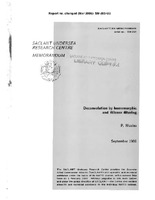| dc.contributor.author | Nicolas, Philippe | |
| dc.date.accessioned | 2018-10-11T14:05:54Z | |
| dc.date.available | 2018-10-11T14:05:54Z | |
| dc.date.issued | 1988/09 | |
| dc.identifier | 1681 | |
| dc.identifier.govdoc | SM-203 | |
| dc.identifier.uri | http://hdl.handle.net/20.500.12489/170 | |
| dc.description.abstract | This study is concerned with deconvolution methods applied to underwater propagation in shallow | |
| dc.description.abstract | water, whereby the received signal is modelled as the convolution between the transmitted pulse and | |
| dc.description.abstract | the medium impulse response. The aim of the method is to extract information on backscattering, | |
| dc.description.abstract | travel time delays, boundary reflection and refraction from the received signal on a point receiver or an array for both seismic and active sonar data. Since experimental data are generally mixed phase, due in part to the multiple reflections (bottom and surface), the conventional linear filtering which assumes the minimum phase property, loses in efficacy. In order to handle this mixed phase characteristic of the data, we proceed in two steps. We first apply a homomorphic filter (complex | |
| dc.description.abstract | cepstrum) to deconvolve the wavelet. Then we deconvolve the medium impulse response by means of Wiener filter. The efficacy of the method is shown on both simulated and real data for explosive and active sonar data. | |
| dc.format | 127 p. : ill. ; 115 fig. | |
| dc.language | English | |
| dc.publisher | NATO. SACLANTCEN | |
| dc.relation.ispartofseries | ADA200582 | |
| dc.subject | Acoustic propagation | |
| dc.subject | Shallow water | |
| dc.subject | Wavelets (Mathematics) | |
| dc.title | Deconvolution by homomorphic and Wiener filtering | |
| dc.type | Scientific Memorandum (SM) | |
